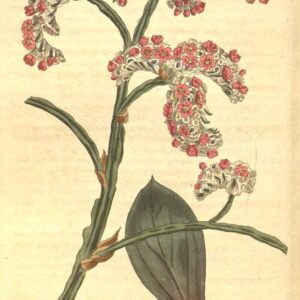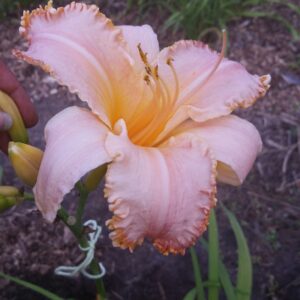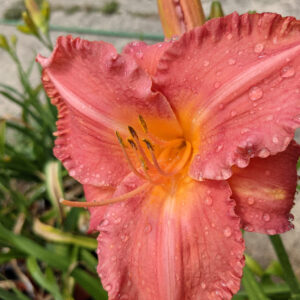"New" Heirloom Plants
Showing 17–24 of 62 results
-
Dracocephalum rupestre in China mao jian cao Z 4-8
True deep blue, hooded flowers rise above heart-shaped, crinkled foliage in the heat of mid-summer
True deep blue, hooded flowers rise above heart-shaped, crinkled foliage in the heat of mid-summer
Size: 12’ X 12”
Care: sun to part shade in well-drained to moist well-drained soil
Native: Western China in alpine meadows and grassy slopesFirst named in the West in 1867, Journal of Botany, British and Foreign, Vol 7 p. 166. Dracocephalum means “dragonhead” in Greek. Chinese made a tea from this.
-
Dryas drummondii Drummond’s mountain avens, Yellow mountain avens Z 3-9
Mat of leathery, wrinkled, creeping foliage, glossy green turning bronze in fall, oval with rounded teeth. From May through July leafless, erect flower stems rise 4-8” above the ground-hugging leaves, with nodding 8 to 10 buttercup yellow petals emerging from a fuzzy, decorative cup.
OUT OF STOCK
Mat of leathery, wrinkled, creeping foliage, glossy green turning bronze in fall, oval with rounded teeth. From May through July leafless, erect flower stems rise 4-8” above the ground-hugging leaves, with nodding 8 to 10 buttercup yellow petals emerging from a fuzzy, decorative cup.
Size: 6-10” x 12-24”
Care: sun in well-drained soil. Drought tolerant
Native: Alaska south to Washington east to Montana, most of Canada1st collected in seed by Sir John Richardson (1787-1865) Scottish naturalist on Franklin’s 1st overland expedition to the Arctic coast, 1819-1822. Franklin called the expedition “disastrous” but went again. Both Richardson and Thomas Drummond (1793-1835) collected this in seed and flower on Franklin’s 2nd overland expedition to the Arctic coast. (1825-1826) It is named to honor Thomas Drummond at Richardson’s request. Curtis’s Botanical Magazine v. 57 ser. 2 (1830). Richardson then led a 3rd expedition searching for Franklin’s last Arctic expedition, finding no trace of the lost ships or men.
-
Erythronium americanum Yellow trout lily, Dog’s tooth violet Z 3-9
Downfacing yellow lily-like recurved flowers in spring above mottled foliage. Tops of petals slightly tan Grows from deep rootstock or corm, 3-5” deep. In time it spreads from offshoots of the corm, resulting in colonies of trout lilies. Ephemeral – dies back in summer.
OUT OF STOCK – Only available for purchase in spring.
Downfacing yellow lily-like recurved flowers in spring above mottled foliage. Tops of petals slightly tan Grows from deep rootstock or corm, 3-5” deep. In time it spreads from offshoots of the corm, resulting in colonies of trout lilies. Ephemeral – dies back in summer.
Size: 3-6” x 4”
Care: part to full shade in moist soil
Native: Eastern No. America, WisconsinCherokee warmed crushed leaves & poured the juice over wounds. According to Cherokee Yellow trout lily also remedied fever, fainting & removed slivers. Used by Iroquois as birth control for young women and to make fish bite (by chewing the root & spitting into the river.) In garden cultivation since 1665. Named Dog’s tooth because the white, oblong, fleshy root is shaped like a dog’s tooth.
-
Gaura lindheimeri syn. Oenothera lindheimeri White gaura, Beeblossom Z 5-9
Multitudes of small white/pink. 4-petaled blossoms on wiry stems from May to October. Cut back by half in July to increase blossoms, as though the hoards are not enough.
OUT OF STOCK
Multitudes of small white/pink. 4-petaled blossoms on wiry stems from May to October. Cut back by half in July to increase blossoms, as though the hoards are not enough.
Size: 36” x 36”
Care: Full sun in well-drained to moist well-drained acidic soil
Native: Texas and Louisiana
Wildlife Value: deer & rabbit resistant. Source of pollen for bees, butterflies and hummingbirds
Awards: Royal Horticultural Society Award of Merit.Gaura is from the Greek gauros meaning superb. Collected in 1851 by German plant hunter Ferdinand Lindheimer (1801-1879) in the Texas Hill Country. Lindheimer considered the Father of Texas botany. L.H. Bailey (1913) wrote: “The best kind is Gaura lindheimeri which has white flowers of singular appearance, with rosy calyx tubes.”
-
Gentiana cruciata Cross-leaf gentian Z 4-9
Reputed the easiest Gentian, its true-blue clusters of short trumpet flowers grow from leaf axils of upper stems, from August through September. Lance-shaped, leathery leaves crowd below and cross one another as its name describes.
Reputed the easiest Gentian, its true-blue clusters of short trumpet flowers grow from leaf axils of upper stems, from August through September. Lance-shaped, leathery leaves crowd below and cross one another as its name describes.
Size: 8-16” x 12-16”
Care: sun to part shade in moist or moist well-drained soil.
Native: much of Europe and East Asia
Wildlife Value: Attracts hummingbirds, butterflies and other insects. Rabbit resistantIn mid-1700’s it was said to grow “. . .in Pannoniae, (province of the Roman Empire bounded on the north and east by the Danube) and Apenninorum, (probably about the Apennines Mountain range of Italy) and Helvetia.” (Switzerland). Linnaeus, Species Plantarum 1: 231. 1753. (1 May 1753) Known more than 600 years ago, possibly before. Leonard Fuchs, German doctor and botanist, (1501-1566) named and described it. Renamed to its current name by botanist Caspari Bauhin (1560-1625) in Pinax Theatricum
-
Goniolimon speciosum syn. Statice speciosa, Limonium Dwarf Statice Z 3-9
Evergreen, flat, agave-like blue-green rosette of leaves. In mid-summer light pink, flat-topped flower clusters held on leafless stems 10-12” above foliage. Very different, fun and easy to grow.
Evergreen, flat, agave-like blue-green rosette of leaves. In mid-summer light pink, flat-topped flower clusters held on leafless stems 10-12” above foliage. Very different, fun and easy to grow.
Size: 10-12’ X 8”
Care: sun in well-drained soil
Native: Steppes of Eurasia: Russia, Siberia, Mongolia & western ChinaCollected by German naturalist Johann Georg Gmelin (1709-1755)1st described in 1753 then named and renamed several times. Pictured in Curtis’s Botanical Magazine 18. No. 656 1803.
-
Hemerocallis ‘Baby Cheeks’
Ruffled margins encircle its broad recurve petals, the color of baby’s cheeks setting off a primrose yellow throat.
Tetraploid daylily. Our own hybrid. Flowers in July.
Ruffled margins encircle its broad recurve petals, the color of baby’s cheeks setting off a primrose yellow throat.Size: 20-30” tall
Care: Full sunOur own hybrid
-
Hemerocallis ‘Orange Taffy’
Broad coral petals with sunshine throat and ruffled petal edges.
Tetraploid daylily. Our own hybrid. Flowers in July.
Broad coral petals with sunshine throat and ruffled petal edges.Size: 20-30” tall
Care: Full sunOur own hybrid




